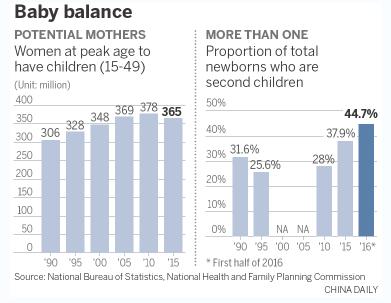
A couple both born after 1990 hold their children, an infant daughter and her 18-month-old elder brother, in Shenyang, Liaoning province, on Jan 3.Many couples responded to the chance to have a second child after policies were eased. LIHAO/CHINA DAILY
Relaxation of limits meant to offset effects of aging population
When China relaxed its four-decade one-child policy at the start of 2016, there were a variety of predictions on whether the change in family planning rules would encourage enough people to have a second child.

Some said there would be too few to offset the effects of an aging population, citing reluctance by urbanites to increase the size of their families in the face of increased costs and new lifestyles.
Others predicted a baby boom because, after all, Chinese people love babies.
Now the numbers are in: In the first half of 2016, the proportion of Chinese newborns who were second children grew to 44.7 percent of total newborns.
That's an increase of some 6.9 percentage points over the proportion of second-child newborns for the whole of 2015, which was 37.9 percent. A total of 8.31 million newborns were registered nationwide this year by the end of June, according to the National Health and Family Planning Commission.
Some regions, mostly large cities, are beginning to see second children comprising more than half of local newborns, the commission said.
Available data indicate it's the highest proportion of second children since China introduced its family planning policies in the late 1970s, limiting most couples to just one child, the commission told China Daily.

In 2014, more exceptions to the one-child policy were introduced, such as the exception that allowed a second child when one parent was an only child. The number of second children began to grow.
The universal two-child policy was adopted by China's top leadership in October 2015, and it began to be implemented nationwide in 2016.
The new statistics make it clear that some families got started early in their planning for a second child, before the policy became official. The numbers are anticipated to go up for the year's second half.
"We expect a clear increase in the total births for this year, and an even larger share of second-child newborns," the commission said.
That's an important development, said Yuan Xin, a population scientist at Tianjin-based Nankai University, who advises the commission.
"If this grows into a trend, then the new two-child policy will prove to be working," Yuan said. What he means by "working", Yuan stressed, is that the policy would held redress, over the long run, the challenge from a dwindling work force and rapidly aging population.
The two-child policy is expected to help push forward China's population peak by two years to 2029, when there will be 1.45 billion people, the commission statement said.
Then the size of population will start tapering off, becoming stable at around 1.38 billion, compared with around 1.2 billion without the policy change, it said.
"The long-term effect of the universal two-child policy, thus, is significant to China's sustainable development," Yuan said.
By the year 2050, it is expected to result in an extra 30 million working-age people and lower the aging rate by 2 percent, commission projections show.
However, "that's based on optimistic estimations," Yuan said. "Uncertainties over the long run remain, like if the younger people are willing to have a second baby, to sustain growth."
He said the policy would, in five years, probably bring about 15 million extra newborns. After 2020 the annual births would start flattening out after hitting around 18 million. Last year, there were 16.65 million newborns, according to the National Bureau of Statistics.
Roughly 60 percent of the women eligible to the right of one additional childbirth are at least 35 years old.
Many of these women aged 35 and older are now rushing against the ticking clock of weakening fertility to have a second baby. That means, Yuan said, "there will be a virtual traffic jam in newborn babies in China in next few years".
Within a few years, second children would account for 40 to 50 percent of the total number of newborns, he projected.
Bai Ying, 36, a Beijing-based engineer, is now four months pregnant with a second child.
"I am concerned about the birth pileup as the future competition in education and employment will become even tougher for my second baby. But my age doesn't allow me to wait any more," she said.
The family planning commission pledged in its statement to collaborate with other departments to make it easier to raise children. Perks in taxation, maternity leave and education are being considered for families with two children.
But it also stressed the long-term population pressure that could be exerted on limited resources and the environment in China.
So, "the country will stick to family planning," it said. There is no timetable for eliminating government rules on the number of children born to a family.
For women like Bai, the newborn traffic jam is being felt the most in large cities.
"I think I will deliver my baby in a private hospital, which is expensive, since it's hard to land a bed in large public hospitals. It would be too crowded, besides," she said.


















































